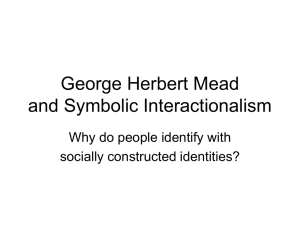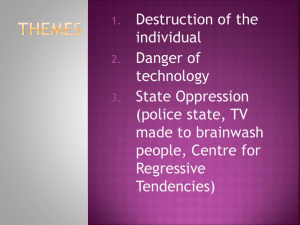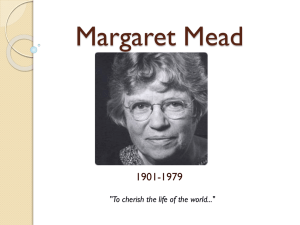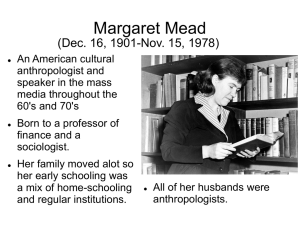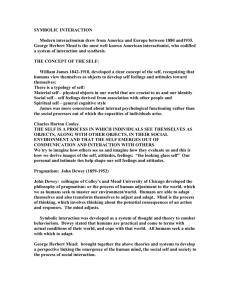Margaret Mead: Taking Note - Christina Beard
advertisement
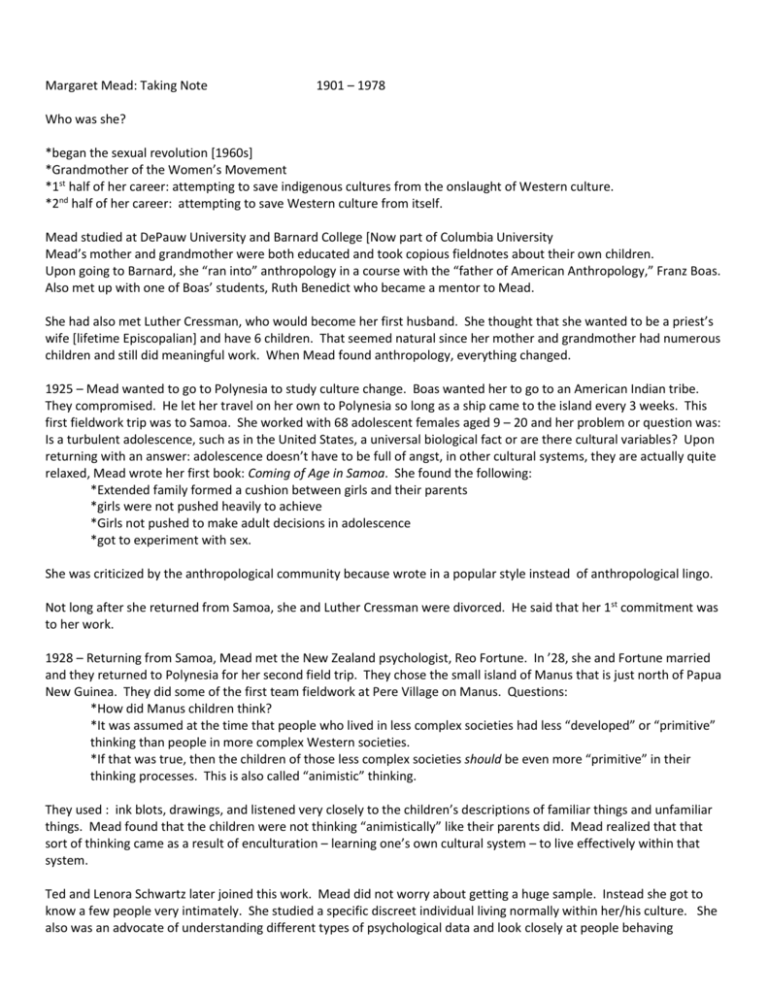
Margaret Mead: Taking Note 1901 – 1978 Who was she? *began the sexual revolution [1960s] *Grandmother of the Women’s Movement *1st half of her career: attempting to save indigenous cultures from the onslaught of Western culture. *2nd half of her career: attempting to save Western culture from itself. Mead studied at DePauw University and Barnard College [Now part of Columbia University Mead’s mother and grandmother were both educated and took copious fieldnotes about their own children. Upon going to Barnard, she “ran into” anthropology in a course with the “father of American Anthropology,” Franz Boas. Also met up with one of Boas’ students, Ruth Benedict who became a mentor to Mead. She had also met Luther Cressman, who would become her first husband. She thought that she wanted to be a priest’s wife [lifetime Episcopalian] and have 6 children. That seemed natural since her mother and grandmother had numerous children and still did meaningful work. When Mead found anthropology, everything changed. 1925 – Mead wanted to go to Polynesia to study culture change. Boas wanted her to go to an American Indian tribe. They compromised. He let her travel on her own to Polynesia so long as a ship came to the island every 3 weeks. This first fieldwork trip was to Samoa. She worked with 68 adolescent females aged 9 – 20 and her problem or question was: Is a turbulent adolescence, such as in the United States, a universal biological fact or are there cultural variables? Upon returning with an answer: adolescence doesn’t have to be full of angst, in other cultural systems, they are actually quite relaxed, Mead wrote her first book: Coming of Age in Samoa. She found the following: *Extended family formed a cushion between girls and their parents *girls were not pushed heavily to achieve *Girls not pushed to make adult decisions in adolescence *got to experiment with sex. She was criticized by the anthropological community because wrote in a popular style instead of anthropological lingo. Not long after she returned from Samoa, she and Luther Cressman were divorced. He said that her 1st commitment was to her work. 1928 – Returning from Samoa, Mead met the New Zealand psychologist, Reo Fortune. In ’28, she and Fortune married and they returned to Polynesia for her second field trip. They chose the small island of Manus that is just north of Papua New Guinea. They did some of the first team fieldwork at Pere Village on Manus. Questions: *How did Manus children think? *It was assumed at the time that people who lived in less complex societies had less “developed” or “primitive” thinking than people in more complex Western societies. *If that was true, then the children of those less complex societies should be even more “primitive” in their thinking processes. This is also called “animistic” thinking. They used : ink blots, drawings, and listened very closely to the children’s descriptions of familiar things and unfamiliar things. Mead found that the children were not thinking “animistically” like their parents did. Mead realized that that sort of thinking came as a result of enculturation – learning one’s own cultural system – to live effectively within that system. Ted and Lenora Schwartz later joined this work. Mead did not worry about getting a huge sample. Instead she got to know a few people very intimately. She studied a specific discreet individual living normally within her/his culture. She also was an advocate of understanding different types of psychological data and look closely at people behaving normally in their own cultural system. Mead stated that the data gives us something to explain rather than an explanation. 1931 – Mead’s third field site was to be in Papua New Guinea among the tribes on the Sepik River. Due to an accident [sprained ankle] she spent a considerable amount of time with three of the tribes closest to the coast: Arapesh, Tchambuli, and Mundugumor. For this work, Mead was looking at the gender roles in society and trying to discover whether standard gender roles that are in play in Western society; feminine=gentle=woman and masculine=aggressive=man ; was a biological universal or due to cultural conventions. Here’s what she found: *Arapesh: both sexes exhibited a gentle/feminine nature *Tchambuli: women=aggressive=masculine while men=gentle=feminine *Mundugumor: both sexes exhibited an aggressive/masculine nature. During this time, she met fellow anthropologist Gregory Bateson. She and Fortune divorced and she married Bateson. Upon returning to the US, she wrote her second book, Sex and Temperament in Three Primitive Societies. Another hit. 1936 – On her fourth expedition into the field, she and Bateson went to Bali. This time, she was looking at how children are affected by their upbringing as they grow up. Since she already had much information from her time in Manus, this became a comparative study that resulted in a series of short films about children and child-rearing around the world. We saw, “Bathing Babies in Three Cultures.” This short used data from PNG/USA/Bali. 1939 – Mead became pregnant with her only child. The famous pediatrician, Dr. Benjamin Spock, was there at the birth as was a film crew and a Child Developmental Psychologist to attend to her daughter, Mary Catherine Bateson, at the moment of birth. Mead said of her observational skills after having her own child that she: *became a poorer observer of children as she compared every one to her own, *became a better observer of mothers as she learned things about mothering she hadn’t known before. Cathy Bateson says her mother took copious notes on Cathy as her mother and her mother’s mother had done on their own children. When Bateson had her own child, Mead became an enthusiastic grandmother perhaps due to the fact that she missed a lot of Bateson’s childhood due to her own work during WWII. 1940s – Due to the outbreak of world war, all travel and fieldwork was suspended for a number of years. Anthropologists began trying to figure out the cultural patterns and national personality especially of Germany and Japan. Since they couldn’t go to the countries, they relied on interviews with immigrants during the war years. Mead helped her old mentor, Ruth Benedict, with this problem. Benedict published The Chrysanthemum and The Sword from this work. Mead also was called to Washington to be on the National Research Council’s Committee on Food Habits & Nutrition during this period. One of the members of that committee said they were trying to do nothing less than “feed the world.” The committee discovered that certain populations needed foods that were common to their own cultural system to make them feel comfortable and well-fed. This was important because during that time there was food rationing and people had to redeem coupons for certain types of foods. [ask your grandparents.] so the question became: should a sustaining program give specific foods to specific cultural groups. The answer was yes. During the war, Mead also tackled a problem happening in England between US soldiers and English women. it appears that in England, at that time, it was incumbent upon males not to get too amorous with their dates. Of course, it's the opposite here in the U.S. and there were some difficulties because of this. Mead identified this problem and gave lectures to service-men to stop the problem. This was one of the first used of anthropology to solve actual problems. That is now known as Applied Anthropology. More to come later in the semester.
